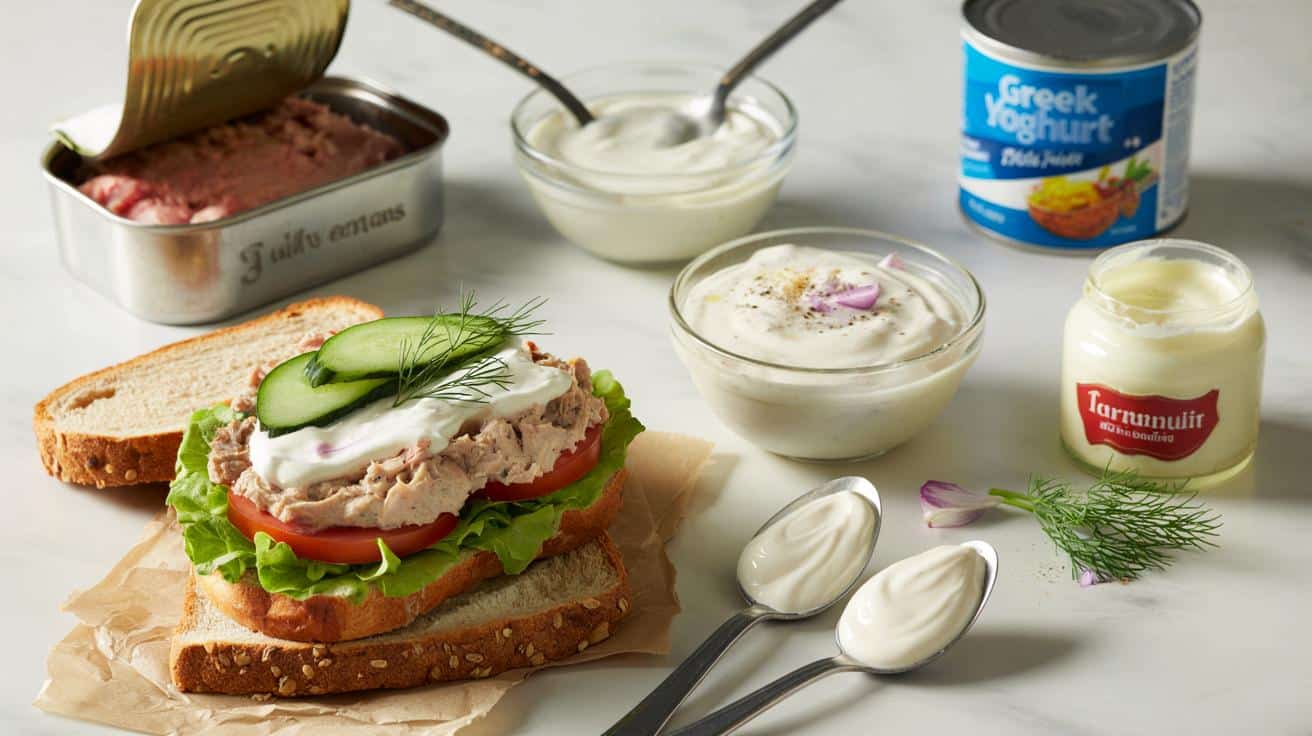A tiny tweak could change that today.
For many readers, the tuna sandwich is a weekday staple: quick, filling and cheap. Yet the classic tuna-and-mayo mix can feel heavy, and the numbers add up fast. A growing number of UK home cooks are switching one ingredient and reporting a brighter flavour, a creamier bite and a better nutritional profile — all without spending more time in the kitchen.
The simple swap changing a British lunchbox
Replace mayonnaise with thick Greek yoghurt. That’s it. Two tablespoons of Greek yoghurt bind tuna just as well as mayo, but with a tang that lifts the fish and a texture that stays rich rather than claggy. You still get the gloss and spread you want across bread, baps or baguettes, while trimming calories and adding protein.
Swap 2 tbsp mayo for 2 tbsp Greek yoghurt and cut roughly 170 kcal while adding around 3 g of protein.
Choose a full-fat or 2% yoghurt if you love a plush mouthfeel; non‑fat will taste sharper and thinner. Full-fat versions are still far leaner than mayonnaise, and many readers prefer their rounded dairy notes with tuna.
How the numbers stack up
Figures below reflect typical UK labels; your brand may vary slightly. The serving shown matches what many people stir into one can of tuna.
| Ingredient (per 30 g / about 2 tbsp) | Energy | Fat | Protein |
|---|---|---|---|
| Mayonnaise (full-fat) | ≈ 200 kcal | ≈ 22 g | < 1 g |
| Greek yoghurt (5% fat) | ≈ 30 kcal | ≈ 1.5 g | ≈ 3 g |
| Greek yoghurt (2% fat) | ≈ 18 kcal | ≈ 0.6 g | ≈ 3 g |
Readers watching macros get a double win: lower energy density and extra protein for better satiety at lunch.
A six-minute method that actually tastes indulgent
Keep it fast and unfussy. Drain the can well, then use the back of a fork to flake the fish lightly so you keep a few appealing chunks.
What you’ll need for one hearty sandwich
- 1 standard tin tuna in spring water, well drained (about 120 g drained weight)
- 2 tbsp Greek yoghurt (5% for extra creaminess, or 2% if you prefer it lighter)
- Pinch of sea salt and black pepper
- 1 tsp lemon juice for brightness
- Optional: 1 tsp Dijon or English mustard, a drizzle of extra virgin olive oil, chopped celery, red onion or capers
Combine the yoghurt, seasoning and lemon first; then fold through the tuna. If you miss mayo’s richness, whisk in half a teaspoon of olive oil — it rounds the flavour without sending calories soaring. Pile onto granary slices, stuff into a soft roll, or spoon into a toasted pitta with shredded lettuce for crunch.
Why the flavour improves
Thick-strained yoghurt carries lactic tang and gentle dairy sweetness that sharpen tuna’s savoury notes. The acidity cuts through oiliness, while the proteins stabilise the mixture so it spreads neatly and doesn’t weep into bread. Lemon juice amplifies that clean finish without turning the filling sour.
It’s not a diet hack pretending to be lunch — it’s a genuine upgrade in texture, freshness and balance.
Make it your way
For creamy traditionalists
Use 5% Greek yoghurt and a small splash of olive oil, plus a half‑teaspoon of mustard. You’ll hit the familiar rounded profile, only lighter and livelier.
For high-protein gym-goers
Pick 2% Greek yoghurt and add extra tuna or a spoon of cottage cheese. The filling becomes thicker and more satisfying without heavy fat.
For a lighter summer bite
Stir in chopped cucumber, dill and a few capers, then serve on rye. The dill pairs well with tuna and yoghurt, echoing Scandinavian flavours.
Which tuna to buy — and how often to eat it
For this mix, tuna packed in spring water works best; the yoghurt brings all the creaminess you need. Skipjack gives a firmer texture and bolder taste, while albacore offers paler flesh and a milder bite. If you prefer tuna in oil, drain thoroughly so the filling doesn’t split.
Pregnant readers and those trying for a baby should follow UK guidance and limit tuna due to mercury: up to two tuna steaks per week, or four medium cans. Canned tuna doesn’t count as oily fish, so you can still plan your weekly salmon or mackerel separately.
Bread, crunch and extras that lift the whole sandwich
- Wholemeal or seeded bloomer adds fibre and a nutty backnote.
- Toast one side only to keep the crumb tender but stop sogginess.
- Layer leaves, then tuna, then tomato to prevent watery bread.
- Finish with sliced gherkins, radishes or a few crisps on the side for texture contrast.
Storage, safety and next-day lunches
Chill the tuna filling in a sealed container and eat within 24 hours. Assemble just before serving to keep bread fresh. If you’re batch-prepping, keep chopped onions separate and fold them in at the last minute; onions can overpower the mix overnight. Live cultures in yoghurt are happiest cold, so avoid heating this filling.
Make once, eat twice: a single 160 g can and 4 tbsp yoghurt will comfortably feed two sandwiches.
Cost and availability
Greek yoghurt sits in most UK chillers in 0%, 2% and 5% versions. Own‑label tubs deliver keen value and last the workweek after opening if sealed and refrigerated. Mayo still has its place in the cupboard; this switch simply gives you another tool for busy days when you want lighter numbers and fresher taste.
Extra ideas to keep your tuna rotation interesting
Turn the mix into jacket-potato topping with chopped chives. Stuff it into baby gem leaves for an easy low‑carb lunch. Fold through sweetcorn for a school‑canteen nod, or add chipotle paste and lime for a smoky twist. For picnics, spoon into mini brioche rolls; the gentle sweetness flatters the tang of yoghurt and lemon.
A quick at-home taste test
Make two small bowls: one with the classic mayo blend, one with Greek yoghurt. Keep the tuna, salt, pepper and lemon identical. Taste blind with your household and tally votes. Many readers report the yoghurt version winning for freshness, while those who want deeper richness prefer adding that teaspoon of olive oil. Either way, the swap takes seconds and could change how you build your midday sandwich all week long.









Tried this today with 5% Greek yoghurt + a splash of olive oil—honestly creamier than mayo and way lighter. Didn’t miss the heft at all; texture stayed rich, not claggy. Definately a keeper.